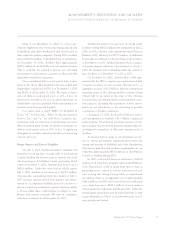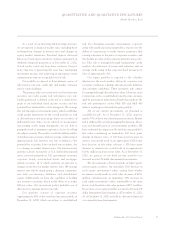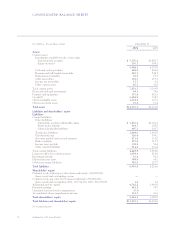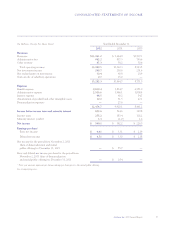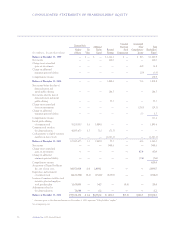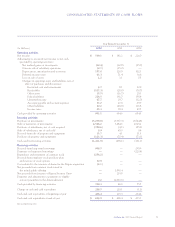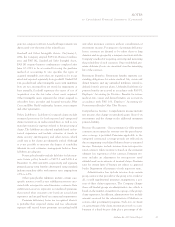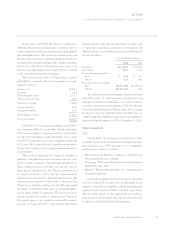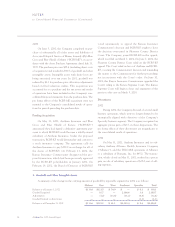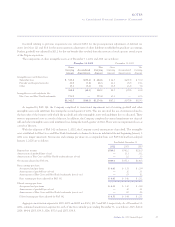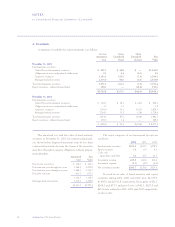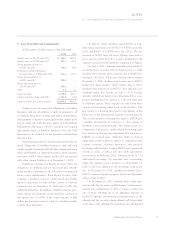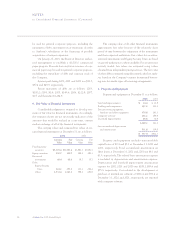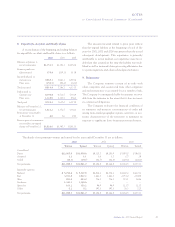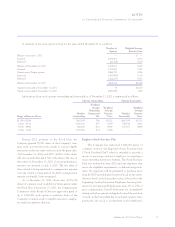Anthem Blue Cross 2002 Annual Report Download - page 67
Download and view the complete annual report
Please find page 67 of the 2002 Anthem Blue Cross annual report below. You can navigate through the pages in the report by either clicking on the pages listed below, or by using the keyword search tool below to find specific information within the annual report.
NOTES
to Consolidated Financial Statements (Continued)
62 Anthem, Inc. 2002 Annual Report
claim amounts processed. Under the Company’s self-
funded arrangements, revenue is recognized as adminis-
trative services are performed. All benefit payments
under these programs are excluded from benefit expense.
Other revenue principally includes amounts from
mail-order prescription drug sales, which are recognized as
revenue when the Company ships prescription drug orders.
Federal Income Taxes: Anthem and the majority of its
subsidiaries file a consolidated income tax return.
Deferred income tax assets and liabilities are recognized
for the differences between the financial and income tax
reporting bases of assets and liabilities based on enacted
tax rates and laws. The deferred income tax expense or
benefit generally represents the net change in deferred
income tax assets and liabilities during the year. The cur-
rent income tax expense represents the tax consequences
of revenues and expense currently taxable or deductible
on various income tax returns for the year reported.
Stock-Based Compensation: The Company has a plan
that provides for stock-based compensation, including
stock options, restricted stock awards and an employee
stock purchase plan. Stock options are granted for a fixed
number of shares with an exercise price at least equal to
the fair value of the shares at the date of the grant.
Restricted stock awards are issued at the fair value of the
stock on the grant date. The employee stock purchase
plan allows for a purchase price per share which is 85% of
the lower of the fair value of a share of common stock on
(i) the first trading day of the plan quarter, or (ii) the last
trading day of the plan quarter. The Company accounts
for stock-based compensation using the intrinsic method
under Accounting Principles Board Opinion No. 25,
Accounting for Stock Issued to Employees, and, accordingly,
recognizes no compensation expense related to stock
options and employee stock purchases. For grants of
restricted stock, unearned compensation equivalent to
the fair value of the shares at the date of grant is recorded
as a separate component of shareholders’ equity and sub-
sequently amortized to compensation expense over the
vesting period. The Company has adopted the disclosure-
only provisions of FAS 123, as amended, Accounting for
Stock-Based Compensation.
Earnings Per Share: Earnings per share amounts, on a
basic and diluted basis, have been calculated based upon
the weighted-average common shares outstanding for the
period after the date of the demutualization and initial
public offering.
Basic earnings per share excludes dilution and is com-
puted by dividing income available to common sharehold-
ers by the weighted-average number of common shares
outstanding for the period. Diluted earnings per share
includes the dilutive effect of all stock options, restricted
stock and purchase contracts included in Equity
Security Units, using the treasury stock method. Under
the treasury stock method, exercise of stock options,
restricted stock and purchase contracts is assumed, with
the proceeds used to purchase common stock at the aver-
age market price for the period. The difference between
the number of shares assumed issued and number of
shares assumed purchased represents the dilutive shares.
Reclassifications: Certain prior year amounts have been
reclassified to conform to the current year presentation.
2. Acquisitions and Divestitures
Acquisition of Trigon Healthcare, Inc.
On July 31, 2002, Anthem completed its purchase of
100% of the outstanding stock of Trigon Healthcare, Inc.
(“Trigon”), in accordance with an agreement and plan of
merger announced April 29, 2002. Trigon was Virginia’s
largest health care company and was the Blue Cross and
Blue Shield licensee in Virginia, excluding the Northern
Virginia suburbs of Washington, D.C. The merger pro-
vides the Company with a new segment (Southeast) with
approximately 2.5 million members and a nearly forty
percent share of the Virginia market.
Trigon’s shareholders each received thirty dollars in
cash and 1.062 shares of Anthem common stock for each
Trigon share outstanding. The purchase price was approx-
imately $4,038.1 and included cash of $1,104.3, the
issuance of 38,971,908 shares of Anthem common stock,
valued at $2,708.1, Trigon stock options converted into
Anthem stock options for 3,866,770 shares, valued at
$195.5 and approximately $30.2 of transaction costs. On
July 31, 2002, the Company issued $950.0 of long term
senior unsecured notes which were used, along with the
sale of investment securities and available cash, to fund
the cash portion of the purchase price.



